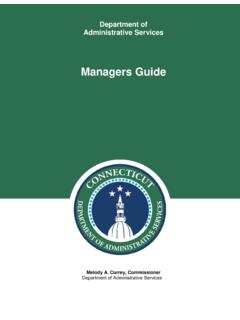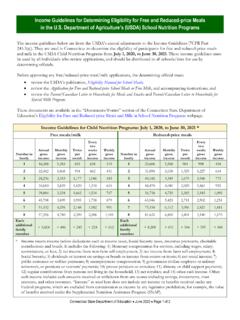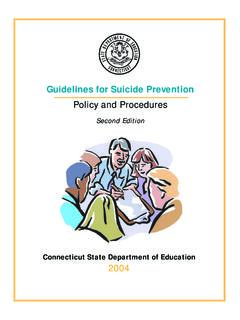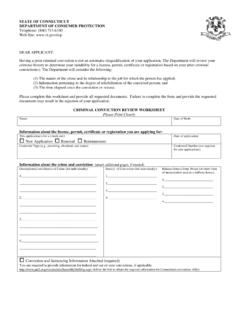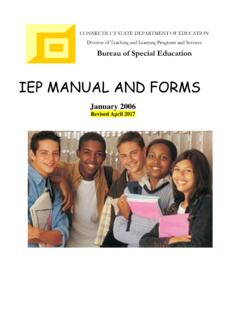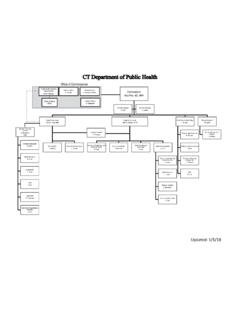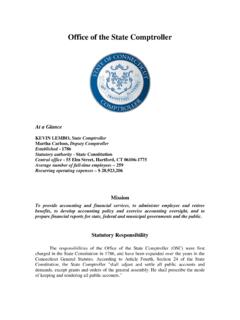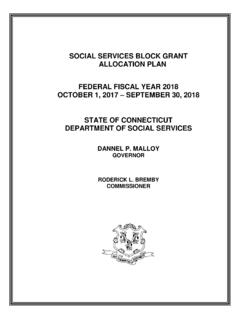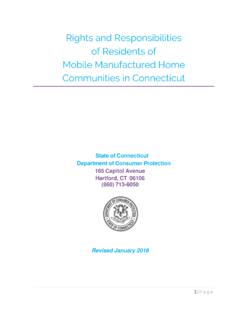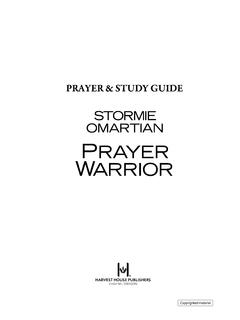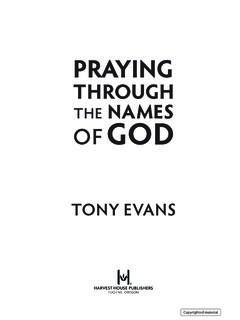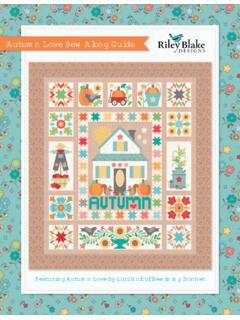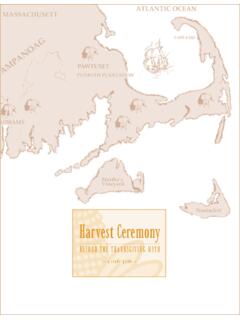Transcription of 2021-2022 Connecticut Migratory Bird Hunting Guide
1 Connecticut Department ofEnergy and Environmental ProtectionKatie S. Dykes, CommissionerBureau of Natural ResourcesRick Jacobson, ChiefWildlife DivisionJenny Dickson, DirectorAugust 2021- March 2022 Migratory BIRDHUNTING GUIDEI ncludes season dates for woodcock, snipe, rails, and crowsThis Guide provides a summary of the most pertinent laws and regulations concerning the Hunting of Migratory birds. No attempt has been made to employ the exact wording of laws and regulations, nor to provide their complete listing. For legal purposes, the Regulations of Connecticut State Agencies and the General Statutes of Connecticut should be NOTE: Regulations related to Hunting may be added or changed during the calendar year. Although we do our best to have the most up-to-date information in this Guide , be prepared for changes to occur. The best way to stay current is to check the DEEP website often, especially before Hunting seasons start, at ; follow our Facebook page at ; and subscribe to our free electronic newsletter Wildlife Highlights ( ) and Connecticut Wildlife magazine ( ; $ for 6 issues).
2 New for 2021-2022 The $13 Connecticut Duck Stamp is merged with the $4 harvest Information Program (HIP) permit into a single $17 Migratory Bird Conservation Stamp. ALL Migratory bird hunters (including crow hunters), regardless of age, must purchase the Connecticut Migratory Bird Conservation Stamp. Hunters under the age of 16 do not need to purchase a Federal Duck Stamp to hunt waterfowl. A 3-day, out-of-state (non-resident) bird Hunting license, which costs $35, allows out-of-state hunters to hunt Migratory and resident (non- Migratory ) game birds for 3 consecutive days. Depending on what species are being hunted, out-of-state hunters still need to purchase a Connecticut Migratory Bird Conservation Stamp and/or Connecticut Resident (non- Migratory ) Game Bird Conservation the second straight year, no Continental breeding surveys were conducted. The Atlantic Flyway breeding waterfowl survey (AFBWS) was completed in 2021.
3 The data from the AFBWS are used to help set the seasons in the Atlantic Flyway. The general duck season in the Atlantic Flyway is now being set based on the collective status of 4 species (wood duck, ring-necked duck, American green-winged teal, and common goldeneye). This is a vast departure from the way the general duck season has been set since 2000, which was based solely on the status of mallards breeding in the northeastern part of the Continent. This new approach has been in the works since 2012 and will result in a season setting process that better accounts for all duck populations and the status of waterfowl habitat in the Atlantic Flyway. More information can be found at mallard bag limit will remain at 2, with 1 hen in the daily bag. The Atlantic Flyway is working towards developing a harvest strategy for mallards, hopefully to be in place for the 2022-2023 season.
4 Until that is set in place, the mallard bag limit will remain at Atlantic Population (AP) Canada goose season will remain at a 30-day season, but the bag limit will drop to 1. This affects the entire AP harvest area in the Atlantic Table of ContentsNew for 2021-2022 ..1 Report Violations ..1 September and Late Canada Goose Seasons ..2 Statewide Youth Waterfowl Hunter Training Days ..2 Connecticut Migratory Bird Conservation Stamp ..2 Federal Migratory Bird Conservation Stamp ..4 Falconry Seasons ..4 Hunter Ethics and Waterfowl Hunting in Urban Settings ..4 Waterfowl Hunter Water Survival Tips ..5 Boating Safety Checklist ..6 Loading the Boat and Under Power ..6 Kayaking/Canoeing and Hunting ..6 Cold Water Boating ..7If You Fall in the Water ..7 Access Restrictions Due to Heightened Security ..7 How Annual Waterfowl Regulations Are Set ..7 Explaining Migrant Canada Goose Seasons.
5 8 Avian Influenza ..9 Open Waterfowl Seasons and Bag Limits ..10 Contaminants in Waterfowl ..12 Rail and Snipe Seasons ..12 Woodcock Season ..12 Crow Season ..12 Federal Regulations ..13 Connecticut Regulations ..15 Local Regulations ..15 State-owned or Controlled Waterfowl Hunting Areas ..18 Report Waterfowl Bands ..20 Don't Forget About HIP ..20 Sunrise/Sunset and Tide Chart ..21 Connecticut Migrant Goose Zones ..back coverThe Connecticut Department of Energy and Environmental Protection is an Affirmative Action/Equal Opportunity Employer that is committed to complying with the requirements of the Americans with Disabilities Act. Please contact Barbara Viadella or Cenit Mirabal, DEEP Office of Diversity and Equity at 860-418-5910 or by email at if you are requesting a communication aid or service, have limited proficiency in English, need some other type of accommodation, or if you wish to file an ADA or Title VI discrimination and photographs used in this publication are copyrighted.
6 Reproduction without permission is artwork 2022 Connecticut Migratory Bird Conservation Stamp Sophie Archer1 Connecticut Department ofEnergy and Environmental ProtectionBureau of Natural Resources / Wildlife Division 79 Elm StreetHartford, CT 06106-5127 is stealing! Shooting before or after hours, overbagging, shooting out of season, and rallying birds are all unethical and illegal Hunting behaviors. If you see violations, report them to DEEP's 24-hour hotline at 1-800-842-HELP (4357). All calls are ViolationsFlyway. This is also the second straight year without a breeding survey and banding effort on this remember that black duck hybrids are classified as black ducks. With the new change in the mallard bag limit, and to reduce any confusion in the field, this move will reduce the chance of a and Late Canada Goose SeasonsNo special permits are required for the special September and late Canada goose seasons.
7 The early season in the North Zone will begin on September 1 and run through September 30. In the South Zone, the season will begin on September 15 and end on September 30. The daily bag limit for the early season is 15, with a possession limit of 45. Shooting hours for the September season are one-half hour before sunrise to one-half hour past sunset, and unplugged shotguns are legal to use. All September goose season hunters must have a federal Duck Stamp and a 2021 Connecticut Migratory Bird Conservation Stamp, which includes the HIP late goose season is from January 15, 2022, to February 15, 2022, in the South Zone only (east of the Quinnipiac River). Goose hunters are reminded that the Atlantic Flyway Resident Population (AFRP) zone has changed and that season runs until February 14, 2022 in the North Zone and February 15, 2022 in the South Zone. The difference in the dates in the AFRP is because all of the allowable Hunting days are being used in both zones.
8 All late season goose hunters must have a federal Duck Stamp, 2022 Connecticut Migratory Bird Conservation Stamp, and 2022 Hunting Youth Waterfowl Hunter Training DaysConnecticut will hold 2 statewide youth waterfowl hunter training days on Saturday, October 2, 2021 and Saturday, November 6, 2021. Junior hunters (ages 12 to 15) must have a valid small game junior Hunting license and a Connecticut Migratory Bird Conservation Stamp (which includes the HIP permit), and be accompanied by an adult at least 18 years of age. Sixteen and 17-year-old hunters can participate in the training days, but they must have a valid Hunting license, a Connecticut Migratory Bird Conservation Stamp, and a federal Migratory Bird Conservation Stamp. Adults must possess a valid Hunting license; however, they are not allowed to carry a firearm. Ducks, geese, mergansers, and coots may be hunted. Bag limits and shooting hours are the same as for the regular duck and goose Hunting Connecticut Waterfowl Association (CWA) sponsors a Waterfowl Hunter Mentoring Program, which pairs up experienced volunteer mentors with youths and adult novice waterfowl hunters.
9 The goal is to encourage new participants in this great sport, who will then appreciate and help conserve our waterfowl resources. The mentors also have the opportunity to give back to the resource they cherish. Mentors of youths are able to enjoy all aspects of waterfowling (except shooting) during the two Youth Waterfowl Hunter Training Days offered each season when only youths can hunt. More information on this program can be found on CWA's website at Information about Junior Hunter Training Days is on the DEEP website at Migratory Bird Conservation StampThe 2021 Connecticut Migratory Bird Conservation Stamp, which expires on December 31, 2021, features a Canada goose, which was painted by Connecticut Junior Duck Stamp winner, Julia Phillips. The 2022 Migratory Bird Conservation Stamp, which features a wood duck, was painted by Connecticut Junior Duck Stamp winner, Sophie Archer, and will be valid from January 1, 2022, through December 31, Duck Stamp Artist: Congratulations are extended to Sophie Archer, age 17, of Old Lyme, CT, whose acrylic painting of a drake wood duck in flight was selected as the "Best in Show" for the 2021 Connecticut Junior Duck Stamp Art Competition.
10 The painting also won first place in the 10th-12th grade age category. Sophie has participated in the Junior Federal Duck Stamp competition from the age of six as a kindergartener. Her love of the arts runs in the family, her mother having graduated from Parson's School of Design, and her grandmother and sister both studying art and working as artists and designers in New York City. Aside from painting, Sophie studies ballet and enjoys baking, pottery, history, and classical literature. Having grown increasingly focused over the years on moving closer to and preserving nature, she feels particularly strongly about the conservation aspect of the Duck Stamp competition and the CWA's mission to preserve and protect the habitat of Connecticut 's wildlife. She feels honored for the opportunity to participate in this ever-growing and ever important project. (The Connecticut Waterfowl Association sponsors and holds the annual Junior Duck Stamp Competition.)
